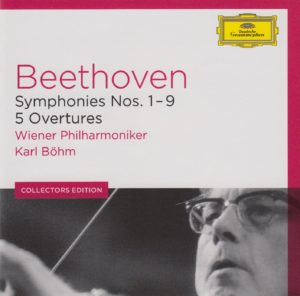
This morning, as I sit on my balcony overlooking the lake, I sip a cup of Chick-fil-A coffee, watch a “flotilla” of geese swimming in single file from right to left across my field of vision, and listen to Karl Bohm (1894-1981) conduct the Vienna Philharmonic Orchestra as they perform Beethoven’s Symphony No. 1 in C Major.
Life is good.
 Regarding Maestro Bohm, here’s what his bio on Wikipedia tells us about him:
Regarding Maestro Bohm, here’s what his bio on Wikipedia tells us about him:
Karl August Leopold Böhm (28 August 1894 in Graz – 14 August 1981 in Salzburg) was an Austrian conductor. Considered particularly gifted in his interpretations of Wagner and Mozart, he has been described by one critic as one of the greatest conductors of the 20th century.
Böhm died in Salzburg, fourteen days before his 87th birthday. Perhaps Böhm’s greatest contribution to music lay in bringing to life the operas of his close colleague Richard Strauss. He conducted the premieres of Strauss’s late works Die schweigsame Frau (1935) and Daphne (1938), of which he is the dedicatee, recorded all of the major operas (but often made cuts to the scores), and regularly revived Strauss’s operas with strong casts during his tenures in Vienna and Dresden, as well as at the Salzburg Festival.
Böhm was praised for his rhythmically robust interpretations of the operas and symphonies of Mozart, and in the 1960s he was entrusted with recording all the Mozart symphonies with the Berlin Philharmonic. His brisk, straightforward way with Wagner won adherents, as did his readings of the symphonies of Brahms, Bruckner and Schubert. His 1971 complete recording of the Beethoven symphonies with the Vienna Philharmonic was also highly regarded.
 I can tell you right now that I am not diggin’ Bohm’s somewhat tentative interpretation. Movement I (Adagio molto – Allegro con brio) seems hesitant, timid. Or maybe it’s the pace. At 9:41, it’s the longest Adagio of the five to which I’ve listened, nearly 50 seconds longer than Barenboim’s, and over 20 seconds longer than Bernstein’s.
I can tell you right now that I am not diggin’ Bohm’s somewhat tentative interpretation. Movement I (Adagio molto – Allegro con brio) seems hesitant, timid. Or maybe it’s the pace. At 9:41, it’s the longest Adagio of the five to which I’ve listened, nearly 50 seconds longer than Barenboim’s, and over 20 seconds longer than Bernstein’s.
Or maybe it’s the 48-year-old recording. It seems to lack the dynamic range of others I’ve heard from the 1970s. In this case, the top end seems to be dampened down a bit. It’s not as crisp.
To check if I could tell what’s missing, I paused Bohm’s version and listened again to Bernstein’s. Yikes. The two are night and day, both in tonal quality as well as in punch. You can hear every instrument in Bernstein’s recording. Barenboim seems to follow Bohm’s somewhat laid back style. But Blomstedt is bolder, more dynamic. (I guess I prefer bolder and more dynamic.)
Whatever the reason, I didn’t start to feel my blood pumping until about half way through Movement I, and then again at the finale – where even I could probably conduct an orchestra and have it sound stirring. Beethoven’s music is just that good.
Speaking of which, in an essay in the liner notes titled “The Measure of All Things: Beethoven’s Symphonies and Overtures” (written by Jurgen Ostmann, translated by J & M Berridge), we learn the following:
“Who can compose anything after Beethoven? asked Schubert. “When Germans speak of symphonies, they speak of Beethoven,” declared Schumann. And Brahms complained about hearing “a giant marching behind me all the time,” without needing to explain who that giant was. Throughout the 19th century, Beethoven’s instrumental works remained the measure of all things. They could enthuse and inspired, but they could also intimidate.
I thought Ostmann’s succinct essay was quite good – vivid and educational.
Beethoven wrote his symphonies in four parts (except for the Sixth, which is in five). The time breakdown of this one (Symphony No. 1 in C Major), from this particular conductor (Bohm, at age 76) and this particular orchestra (Wiener Philharmoniker), at this particular time in history (1970) on this particular record label (Deutsche Grammophon) is as follows:
I. Adagio molto………………………………………………………………………………..9:41
II. Andante cantabile con moto………………………………………………………8:47
III. Menuetto. Allegro molto e vivace……………………………………………….4:01
IV. Adagio – Allegro molto e vivace…………………………………………………6:31
Total running time: 28:20
My Rating:
Recording quality: 4 (not quite up to DG’s high standards, a bit of hiss at times)
Overall musicianship: 4 (doesn’t feel inspired to me)
CD liner notes: 3 (short essay about Beethoven, lyrics in French, German, English, but nothing about Bohm or the Vienna Philharmonic Orchestra)
How does this make me feel: 3
I have no idea why this recording rates a mere “Meh” from me. But nothing is grabbing me by the lapels and yelling, “Sit down and listen to this!”
Classical music, like great paintings, photographs, or novels, is subjective. One person’s masterpiece is another person’s tripe.
To each his own.
NOTE: I’m not sure what to do with the information that Karl Bohm had dealings with the Nazi Party in Germany back in the day. His bio on Wikipedia tells us,
On 28 December 2015 the Salzburg Festival announced that it will affix a plaque on its Karl Böhm refreshment lobby (Karl-Böhm-Saal) acknowledging the conductor’s complicity with Nazi Germany, which will say that “Böhm was a beneficiary of the Third Reich and used its system to advance his career. His ascent was facilitated by the expulsion of Jewish and politically out-of-favor colleagues” [“Böhm war ein Profiteur des Dritten Reichs und arrangierte sich für die Karriere mit dem System. Sein Aufstieg wurde durch die Vertreibung jüdischer und politisch missliebiger Kollegen begünstigt”]. Austrian Radio (ORF) quoted Festival president Helga Rabl-Stadler as calling Böhm as “a great artist but fatally flawed politically” [“Ein großer Künstler, aber politisch fatal Irrender”].
Part of me is, like, “So what? Weren’t most Germans Nazis back then?”
And what if Bohm was? A young man in his twenties and thirties, even into his yearly forties, is a different man from when he’s in his sixties, seventies, and eighties. Must a man be forever saddled with what he was, rather than what he is?
Herbert von Karjan (a fellow Austrian) supposedly also had an affinity for the Nazi Party when he was much younger. What does that mean to us today? Once a Nazi always a Nazi?
I hesitate to even print this information. Yet, it’s part of who these people were, and – as indicated by the recent news from the Salzburg Festival – it’s still news today. I’m just not sure how much to make of it.
